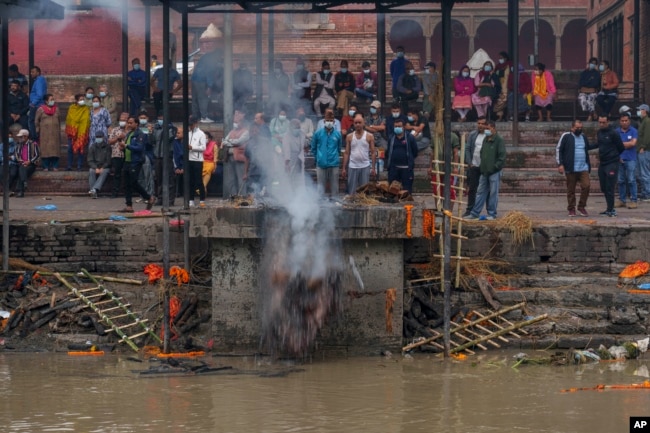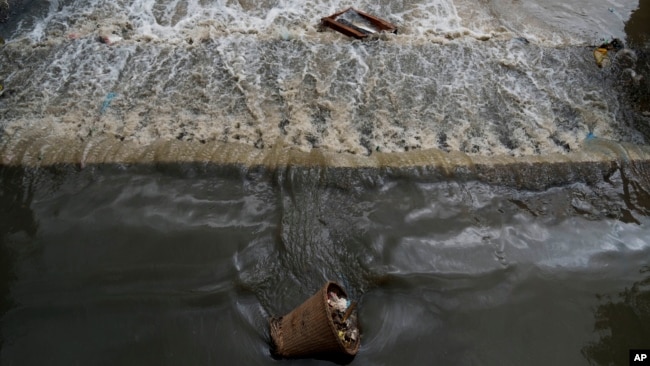写真からでも悪臭が漂ってきそうです。
どうか、どうか 神よ 我々に浄化の力を与え賜え!!
VPAで英語を学びましょう!!
バグマティ川:ネパールで最も神聖で、最も汚れた川(和訳)
The Bagmati: Nepal’s Holiest, and Dirtiest, River
August 26, 2022
ネパールで最も神聖な川、バグマティ川は、ヒマラヤ山脈の高地から始まります。古来より宗教的に尊ばれてきました。その水には魂を浄化する力があると言われています。
しかし、バグマティ川は汚染されています。森や農地、町など、約600kmの道のりを進むうちに、バグマティ川は汚染で黒く変色し始めます。首都カトマンズに着くころには、ゴミだらけで真っ黒です。
水は飲めません。掃除にも使えません。乾季には川底から悪臭が漂います。
現在、バグマティ川はネパールで最も汚染された川となっています。悪化した状況は、カトマンズに住む300万人の人々の川との付き合い方を大きく変えてしまいました。
首都カトマンズでは、パシュパティナート寺院をはじめとするいくつかの聖地を、バグマティの水がゆっくりと流れています。パシュパティナート寺院は、1979年にユネスコの世界遺産に登録されました。ヒンズー教の神シヴァ神をはじめ、より小さな神々を祀る巨大な寺院です。
ヒンドゥー教徒はカトマンズの川岸に集まり、神社に参拝し、休日や祭りを祝います。リシパンチャミの祝日には、女性が川に入って罪を洗い流します。チャトの祭りでは、観光客も水に入ります。
家族は長い間、亡くなった大切な人の遺体を川まで運び、足を洗い、顔に水滴を振ってきました。川は人の過ちを洗い流し、魂を天国に送ってくれると信じられているのです。その後、遺体は川のほとりで焼かれ、その灰が川に投げ込まれます。
今でもバグマティに死者を連れてくる人はいますが、水と接触する人はほとんどいません。
「今はもう、そういうことはありません。水はとても汚く、悪臭を放っています。人々はペットボトルの水を持参して儀式を行うことを余儀なくされています。」と59歳のミトゥ・ラマさんは言います。彼女は15歳のときから夫と一緒にテク・ガット の火葬場で働いてきました。
また、人々は伝統的に川の水を集めて、家を清めるために使ってきました。仏教徒にとっても、この川は意味があります。バグマティ川以外で遺体を荼毘に付す人も多くいます。
川のそばで生まれ育ったラマさんは、料理や入浴、洗濯、そして飲用にも川の水を使ったことを思い出します。しかし、今となっては、その夢もゴミの投棄で終わってしまったような気がします。
「私が生きている間に、この川がきれいになるとはとても思えません。」とラマさんは言っています。「でも、汚したのは人間なんです。人間が問題なのです。」
川をきれいにするために、民間のボランティアと政府の両方による取り組みが行われてきました。例えば、過去7年間、毎週土曜日に数百人のボランティアがカトマンズに集まり、バグマティ川からゴミを撤去してきました。
マラ・カレルさんは、毎週土曜日のその群衆の中にいます。彼女は、バグマティ文明の統合開発のための政府高官委員会の役員を務めています。この委員会は、バグマティ川をきれいにするために設立されました。彼女は自分の時間を割いて、汚染を避けるための住民の意識を高めるボランティアをしています。
カレルさんによると、このキャンペーンで川沿いのゴミの約8割を回収することに成功したそうです。ボランティアによると、ゴミのほか、動物の死体や赤ちゃんの遺体まで見つかるそうです。清掃活動は困難であり、さらに多くのことを行う必要があります。
また、何千人もの人々が川沿いに違法に家やシェルターを建て、そこから離れようとしないのです。
 A man looks at the polluted Bagmati River from the Pashupatinath Temple in Kathmandu, Nepal, Monday, April 25, 2022. The Bagmati’s sludge oozes past the temple, declared a World Heritage Site by UNESCO in 1979, and several other sacred sites in the city. (AP Photo/Niranjan Shrestha)2022年4月25日月曜日、ネパール、カトマンズのパシュパティナート寺院から汚染されたバグマティ川を眺める男性。バグマティの汚泥は、1979年にユネスコによって世界遺産に指定された寺院や、市内のいくつかの聖地を通り過ぎ、にじみ出ている。(AP写真/Niranjan Shrestha)
A man looks at the polluted Bagmati River from the Pashupatinath Temple in Kathmandu, Nepal, Monday, April 25, 2022. The Bagmati’s sludge oozes past the temple, declared a World Heritage Site by UNESCO in 1979, and several other sacred sites in the city. (AP Photo/Niranjan Shrestha)2022年4月25日月曜日、ネパール、カトマンズのパシュパティナート寺院から汚染されたバグマティ川を眺める男性。バグマティの汚泥は、1979年にユネスコによって世界遺産に指定された寺院や、市内のいくつかの聖地を通り過ぎ、にじみ出ている。(AP写真/Niranjan Shrestha)
し尿に関しては、委員会は川沿いに新しい運河やパイプを作るなど、いくつかのプロジェクトに取り組んでいます。これらは下水道に接続され、廃棄物がバグマティに到達するのを防ぐためのものです。
また、廃棄物処理場の建設も検討しています。そして、モンスーンの季節に雨水を貯留し、乾季に川に放流するための新しいダムの建設にも着手しています。これは、カトマンズから下流に廃棄物を移動させるのに役立つ可能性があります。
パイプと運河システムの工事は2013年頃に始まりましたが、完成時期は発表されていません。2つのダムの建設は続いており、完成間近と伝えられています。もうひとつのダムも着手しています。しかし、運動家たちは大きな期待を寄せています。
「今後10年で、川が澄んだ流れになり、土手がきれいになって木々が立ち並ぶことを期待しています 。」とカレルさんは言います。「私たちはこの目標を掲げて頑張っています。」
その希望的観測は、すべての人に共有されているわけではありません。環境保護活動家の中には、ダムが大きな助けになるかどうかわからないという人もいます。
「このダムには大きな期待が寄せられています。バグマティは自然の川であり、そう簡単に掃除できる運河ではありません。」と、川をよく研究している科学者のマドゥカール・ウパディヤ氏は言います。
彼は、砂は残っていないと言っています。現在では粘土が敷き詰められ、産業活動から出る化学物質が混ざっています。
「すでに多くのダメージを受けているため、ある程度は浄化できるかもしれないが、過去の栄光を取り戻すことはできない。」とウパディヤ氏は語ります。
The Bagmati: Nepal’s Holiest, and Dirtiest, River
Nepal’s holiest river, the Bagmati, begins high in the Himalaya Mountains. It has been honored religiously since ancient times. Tradition says its waters have the power to purify souls.
But the Bagmati itself is polluted. Along its almost 600-kilometer path through forests, farmland, and towns, the Bagmati starts to darken with pollution. It is black and full of trash by the time it reaches Kathmandu, the capital.
The water is undrinkable. It is not useful for cleaning. During the dry season, a bad smell rises from the riverbed.
Today, the Bagmati is Nepal’s most polluted river. The worsening conditions have sharply changed the way Kathmandu’s three million people interact with the river.
In the capital, the Bagmati’s waters travel slowly past several holy places, including the Pashupatinath Temple. It was declared a World Heritage Site by UNESCO in 1979. The huge complex honors the Hindu god Shiva, and other, lesser gods.
Hindus gather on the riverside in Kathmandu to worship at shrines and celebrate holidays, or festivals. Women enter the river to wash away sins during the Rishipanchami holiday. Visitors also get in the water during the festival of Chhath.
Families have long carried the bodies of loved ones who have died to the river to wash their feet and shake drops of water on their faces. Beliefs hold that the river washes away a person’s wrongs and sends their soul to heaven. Later, the body is burned along the banks of the river and the ashes are thrown into the water.
People still bring the dead to the Bagmati, but few make contact with the water.
“That is no more now. The water is so dirty and stinks. People are forced to bring bottled water and do the rituals,” said 59-year-old Mithu Lama. She has worked with her husband at the Teku ghat cremation grounds since she was 15.
People have also traditionally collected river water to use on their homes to purify them. The river is meaningful to Buddhists, as well. Many cremate bodies besides the Bagmati.
Born and raised next to the the river, Lama recalled using its waters for cooking, bathing, washing and even drinking. Today that feels like a long-ago dream ended by the dumping of human waste and trash.
“I now have serious doubt that it will be cleaned in my lifetime,” Lama said. “Not that there has not been any efforts, there have been several cleaning campaigns, but there are more people dirtying it. People are the problem.”
There have been efforts by both private volunteers and the government to clean up the river. For example, for the last seven years hundreds of volunteers have gathered in Kathmandu every Saturday to remove trash from the Bagmati.
Mala Kharel is among that crowd most Saturdays. She is an executive member of the governmental High Powered Committee for Integrated Development of the Bagmati Civilization. It was set up to help clean up the river. She volunteers her time to raise awareness among the population about avoiding pollution.
Kharel said the campaign has succeeded in collecting about 80 percent of the trash along the side of the river. The volunteers say they find trash, dead animals and even the bodies of babies. The cleanup effort is difficult and more needs to be done.
In addition, many thousands of people have built homes and shelters illegally along the river and refuse to leave.
As for the human waste, the committee is working on several projects including new canals and pipes alongside the river. Those are to connect to sewer lines to prevent waste from reaching the Bagmati.
The group also is considering a waste treatment plant. And it has started building new dams where rainwater can be captured during the monsoon season and released into the river during the dry months. This could help move waste downstream from Kathmandu.
Work on the pipe and canal system began around 2013, but no completion date has been announced. Building on two dams is continuing and reportedly close to completion. Another dam is getting started. But campaigners have high hopes.
“In the next 10 years, I am hoping the river will be flowing clear and the banks will be clean and lined with trees,” Kharel said. “We are working hard with this target.”
The hopefulness is not shared by everyone. Some environmentalists do not know if the dams will be of much help.
“There is too much expectations from these dams. Bagmati is a natural river and not a canal that can be cleaned so easily,” said Madhukar Upadhya, a scientist who studies the river closely.
He said no sand is left. Today it is lined with clay and mixed with chemicals from industrial activity.
“So much damage has already been done to it,” Upadhya said, “that it can perhaps be cleaned to some degree but not restored to its past glory.”
Words in This Story
trash –n. things that are no longer useful or wanted and that have been thrown away
shrine –n. a place connected with a holy person or event where people go to worship
stink –v. to smell bad
ritual –n. a formal ceremony or series of acts that is always performed in the same way
cremation –n. the process of burning the body of someone who has died
doubt –v. to not believe
awareness –n. to have knowledge of something
sewer –n. something that removes waste and water
glory –n. praise, honor or fame


